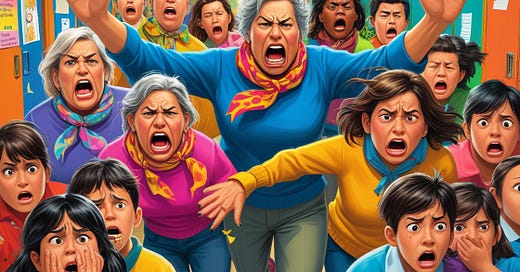How Commonly are Critical Race Theory (ish) Ideas Taught in K-12 Schools?
And what harms are they or are they not associated with in youth? Results from a new study!
Beginning in 2021, intense debates roiled regarding the teaching of Critical Race Theory (CRT) and other identitarian belief systems in American K12 schools. CRT is a legal theory that holds that race and race discrimination remain central to the US justice system. CRT often voices skepticism of both the civil rights movement and traditional liberal values such as free speech. Other far-left identitarian theories around sex, gender, mental illness, etc., tend to follow similar patterns. They hold that demographic identity remains a core divide in society, often broken down along clear oppressor/oppressed binaries.
When faced with criticism of CRT influenced teaching, progressives often contended either that such theories weren’t being taught in K12 schools or, if they were, used motte-and-bailey arguments to suggest such instruction merely involved teaching the history of slavery or basic concepts of race. With the election of Donald Trump, as well as in states with Republican Governors, CRT is now being purged from school systems.
The push to eliminate CRT from schools (and other settings) is often associated with conservative activist Chris Rufo. In Rufo’s parlance, CRT is often used as a shorthand for all far-left identitarian theories. To be a bit clearer, I tend to use the term CRT(ish) which both recognizes the role of CRT, but also other left identitarian belief systems. In common, these belief systems tend to agree that demographic identity is the most important form of identity, at least for policy, that liberal values such as free speech are often used against minorities, that people can be divided along clear oppressor/oppressed categories based on identity, and that the histories of the US and Europe tend to be particularly despicable compared to the rest of the world (and certainly indigenous cultures, who are often portrayed as innocent children).
During the debates regarding K12 education, few could agree how common CRT(ish) influences in education were, nor what impact they had on youth. A few studies by Eric Kaufman and Zack Goldberg found that CRT influenced education was quite common in US and UK schools. But replication can be good, and there was less data on what correlations this mode of teaching might have on youth, for ill or for good.
So, I designed my own study, now accepted for publication in the journal Current Psychology. I wanted to see how commonly were kids 13-18 exposed to CRT(ish) teaching in American schools. I also wanted to see how such teaching correlated with left-wing authoritarianism, ethnocentrism (a component of racism), mental health problems, classism and trait victimhood. Given some activist groups also complain that teaching of American history is “whitewashed”, that is, avoiding difficult topics around race, slavery, etc., I also wanted to see whether this was true. To assess this, I asked students whether their teachers had taught them some uncontroversially true but unflattering aspects of US history such as ““Intermarriage between black and white Americans was illegal in many states until the 1960s” and “Many Founders of the United States owned slaves.” There were also several distractor questionnaires to cut down on false correlations due to hypothesis guessing, as well as unreliable and mischievous responding checks.
For CRT(ish) teaching I asked students whether their teachers had taught them things such as “The United States is more racist than other cultures/nations” or “Unarmed black people are being shot by police very often” or “Gender is a social construct.” Unlike the historically true questions, these questions were either factually false, such as the question about police shooting black Americans, or were simplistic progressive mantras on complicated biological or social phenomenon such as gender identity.
221 youth in the United States filled out the survey. The results have a little bit for everyone to like and not like.
Keep reading with a 7-day free trial
Subscribe to Secrets of Grimoire Manor to keep reading this post and get 7 days of free access to the full post archives.




